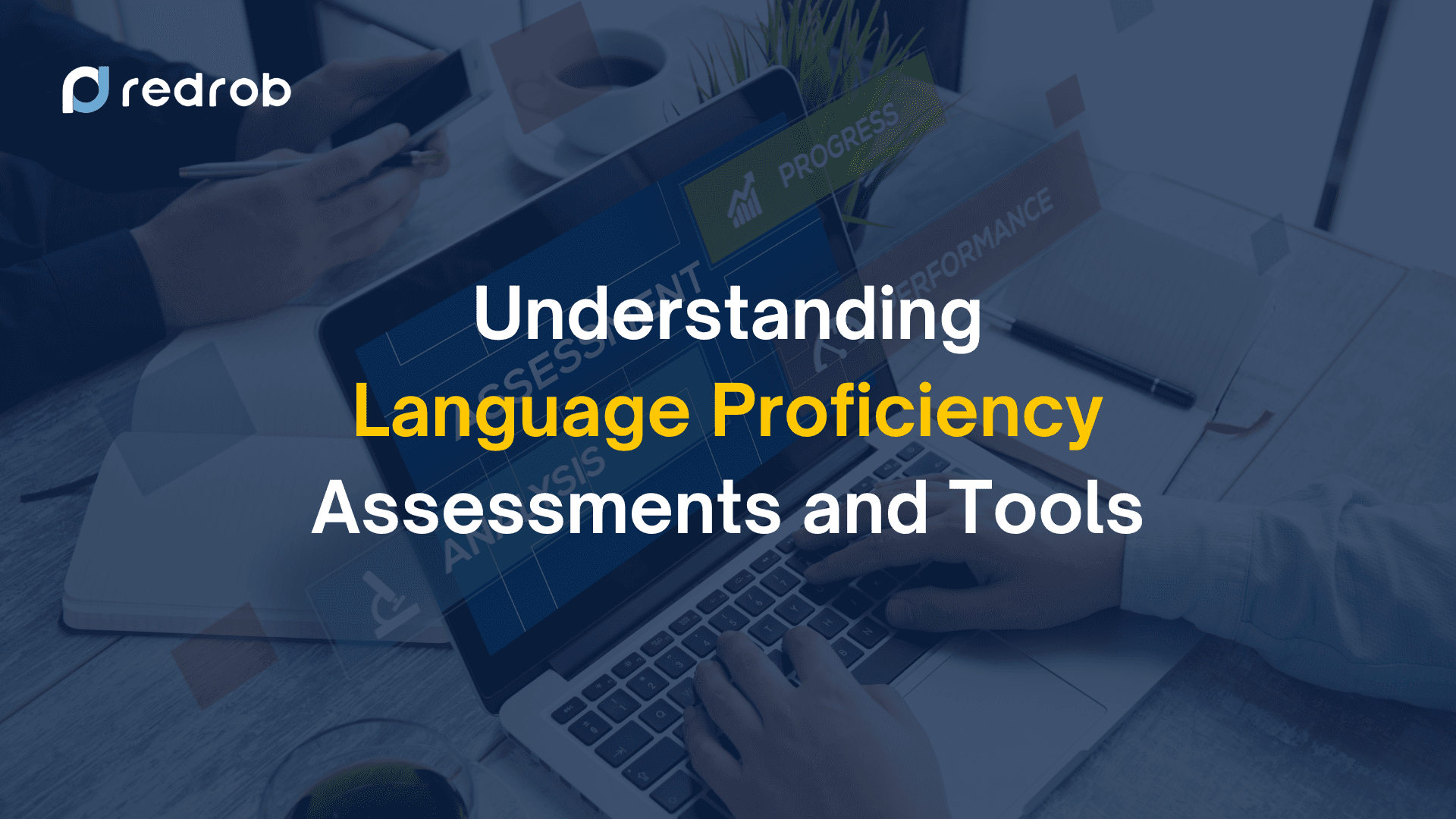Language Proficiency Assessments
7 mins read
•
Nov 1, 2024

Soumyata Singh
How well can you measure someone’s language skills? Whether for academic placement or job suitability, the ability to assess language proficiency is more important than ever. That’s where language proficiency assessment tools come in. These tools provide clear, measurable results, helping you make informed decisions.
But with so many options available, how do you choose the right tool? In this blog, we’ll explore the different types of assessments, compare top tools, and offer tips for selecting the perfect solution. Keep reading to discover how these tools can transform your evaluation process.
Purpose and Context of Language Proficiency Assessments
Language proficiency assessment tools help measure your ability to understand and communicate in a language. Whether you’re applying for a job or enrolling in school, these tests show how well you can use language in real-life situations.
In academic settings, these assessments often determine your placement. For example, students may be grouped by language ability to receive proper instruction. For job qualifications, employers use these tools to ensure you meet specific language requirements for roles that demand clear communication.
Both academic and professional environments rely on these assessments to evaluate whether you’re capable of understanding and using a language effectively.
Forms of Language Testing
Language proficiency assessment tools come in various forms to measure different aspects of language skills. These tests serve specific purposes, whether for learning, placement, or real-world language use.
1. Aptitude Tests
Aptitude tests assess your capacity to learn new language skills. These are commonly used when you’re just beginning to learn a language. They help determine how quickly you can pick up new vocabulary, grammar, and pronunciation rules. For example, if you're applying to a language learning program, this test measures your potential for success. A company may use language aptitude tests to screen candidates for positions requiring fast language acquisition. Studies show that language aptitude tests can predict up to 40% of success in learning a new language.
2. Diagnostic Tests
Diagnostic tests reveal your current language abilities, showing where your strengths and weaknesses lie. These tests provide insights into specific areas—such as speaking, reading, or writing—so you can focus on improving those skills. Teachers often use these assessments to develop targeted learning plans for students. After taking a diagnostic test, a student might discover they need extra help in listening comprehension.
3. Placement Tests
Placement tests group students by their language skill levels. They are often used in academic settings to ensure you’re placed in the appropriate course level. These tests make sure that everyone in the class has similar skills, promoting effective learning. For example, a university may require international students to take a placement test before enrolling in language courses.
4. Achievement Tests
Achievement tests evaluate how much you’ve learned in a language over a period of time. These tests focus on specific knowledge, such as vocabulary and grammar, and track your progress. Achievement tests are usually used at the end of a period to measure a candidate’s progress. Achievement tests are commonly used by language instructors to gauge student growth.
5. Proficiency Tests
Proficiency tests measure your ability to use language in real-life situations. Unlike achievement tests, which focus on learned material, proficiency tests assess how well you can communicate in everyday contexts. These are often used for job qualifications or academic certifications. A proficiency test may be required for a job where communication with clients is essential.
With these various forms of language testing, you can measure different skills depending on your needs. In the next section, let’s explore specific language proficiency assessment tools that help bring these tests to life.
Skills Assessed in Language Testing
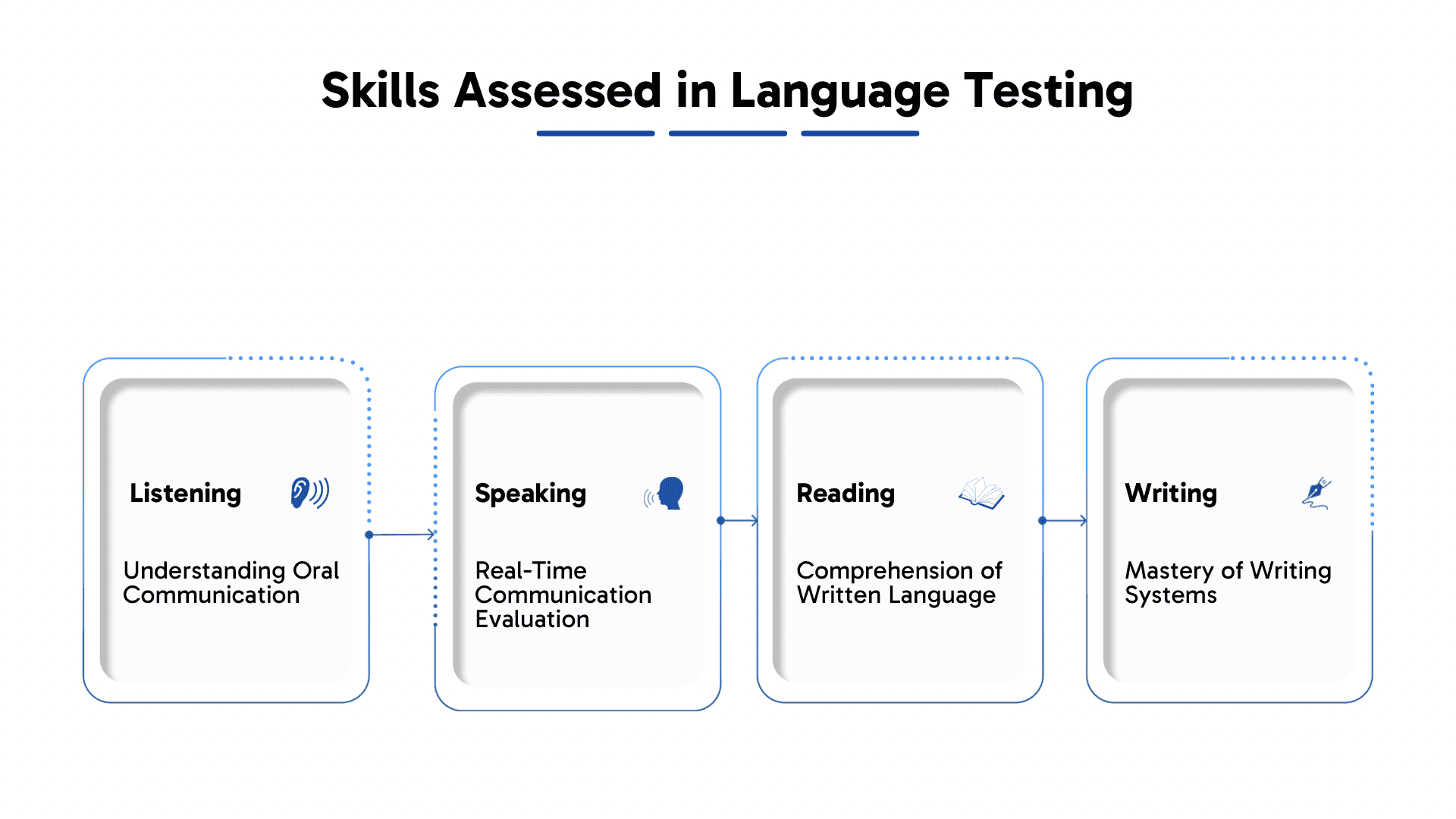
Language proficiency assessment tools evaluate different skills that are essential for effective communication. Whether it's understanding spoken language or expressing yourself in writing, these tools help measure your overall language proficiency.
1. Listening: Understanding Oral Communication
Listening skills are critical for comprehending spoken language in real-time. Language proficiency assessment tools test your ability to understand conversations, instructions, or presentations in different contexts. Listening tests might involve hearing a passage or dialogue and answering questions based on what was said. For example, an English proficiency test might require you to listen to a recorded conversation and then choose the correct answers from a list of questions.
2. Speaking: Real-Time Communication Evaluation
Speaking skills focus on how well you can express ideas in real time. Language proficiency assessment tools often ask you to respond to questions or prompts orally. Your pronunciation, grammar, fluency, and ability to communicate effectively are all evaluated during these tests. You may need to give a brief oral presentation or answer interview-style questions to demonstrate your speaking ability.
3. Reading: Comprehension of Written Language
Reading tests evaluate how well you understand written material. These assessments may include reading passages followed by questions that check your comprehension. Language proficiency assessment tools often use reading tasks to measure vocabulary, grammar understanding, and the ability to grasp complex ideas. In a reading assessment, you might read a news article and answer questions on key details.
4. Writing: Mastery of Writing Systems
Writing skills are tested to see how well you can organize thoughts and use correct grammar and vocabulary in written form. Language proficiency assessment tools usually involve tasks like writing an essay or responding to specific prompts. The goal is to check your ability to convey ideas clearly and appropriately in writing. You could be asked to write an email or a short essay to demonstrate your writing proficiency.
Understanding these key language skills helps you focus on areas that need improvement. Next, let’s explore the leading language assessment tools that can test these skills effectively.
Leading Language Assessment Tools
When it comes to evaluating language skills, finding the right tools is crucial. Whether you’re looking for assessments for academic or professional settings, several language proficiency assessment tools stand out. These tools help measure your ability in reading, writing, listening, and speaking. In this section, we'll explore some of the top tools available today, breaking down their key features to help you choose the right one.
1. Redrob
Redrob is designed to simplify language testing for both academic and professional use. This platform stands out among language proficiency assessment tools by offering 3500+ user-friendly tests that focus on accuracy and real-world language skills. The best part, these are all customizable. Whether you're assessing fluency or an employee's communication ability, Redrob makes it easy to get reliable results.
Key Features:
Provides comprehensive tests for various languages.
Tailored assessments for academic and job-related language proficiency.
User-friendly interface, easy to understand for both candidates and administrators.
Results available instantly with detailed feedback.

2. TestGorilla
TestGorilla offers customizable language proficiency assessment tools that fit a variety of needs. It’s perfect for businesses or schools that require flexible, in-depth testing solutions. With a wide selection of tests, you can evaluate candidates’ real-life communication abilities in multiple languages.
Key Features:
Over 30 language tests covering different levels and industries.
Customizable assessments to suit specific needs.
Detailed reporting on all language skills, including real-time speaking tests.
Integrates seamlessly with various recruitment and HR tools.
3. iMocha
If you're looking for language proficiency assessment tools for a professional setting, iMocha is an excellent option. It’s tailored for businesses, providing specialized tests for workplace communication skills. iMocha’s assessments ensure that employees have the language abilities required to thrive in global industries.
Key Features:
Offers business English tests alongside other language options.
Measures skills required for the workplace, such as communication and writing proficiency.
Instant grading and feedback to track progress.
Supports testing in several languages for global enterprises.
4. Test Candidates
Test Candidates combines language proficiency assessment tools with soft skills evaluation. It’s ideal if you need to assess more than just language ability. With multiple language tests and detailed insights, this tool gives you a well-rounded picture of an individual’s communication and interpersonal skills.
Key Features:
Tests available in multiple languages, including less commonly spoken ones.
Evaluates language skills and soft skills together.
Detailed insights into test results, helping identify areas of improvement.
Easy integration with professional and academic setups.
5. Testlify
Testlify takes language proficiency assessment tools to the next level by offering AI-powered testing. This tool helps you measure language skills at different levels, from beginner to expert. Its user-friendly platform and multi-language support make it a great choice for global teams and organizations.
Key Features:
AI-driven recommendations to select the right test for the role.
Multi-level testing capabilities, from beginner to advanced.
User-friendly dashboards for easy monitoring of test results.
Multiple languages supported, catering to global teams.
These language proficiency assessment tools offer a variety of features to help evaluate language skills effectively. Each tool has its unique strengths, depending on your specific needs, be it for job recruitment or academic purposes.
Evaluating the Effectiveness of Language Testing Tools
When choosing language proficiency assessment tools, effectiveness is key. You want tools that provide clear insights into language skills. This section highlights the importance of these tools and offers guidance on selecting the best ones.
Importance in Quantifying Language Ability Objectively
Quantifying language ability objectively is crucial for making informed decisions in both academic and professional settings. Language proficiency assessment tools provide measurable results that ensure fairness and consistency across all test-takers.
Without objective measures, it’s hard to accurately gauge someone's language skills. Subjective evaluations can lead to inconsistencies, especially in hiring or academic placement. For example, a business may need to assess candidates' communication abilities in multiple languages. Without standardized testing, the evaluation process would be unreliable.
Why objective language testing matters:
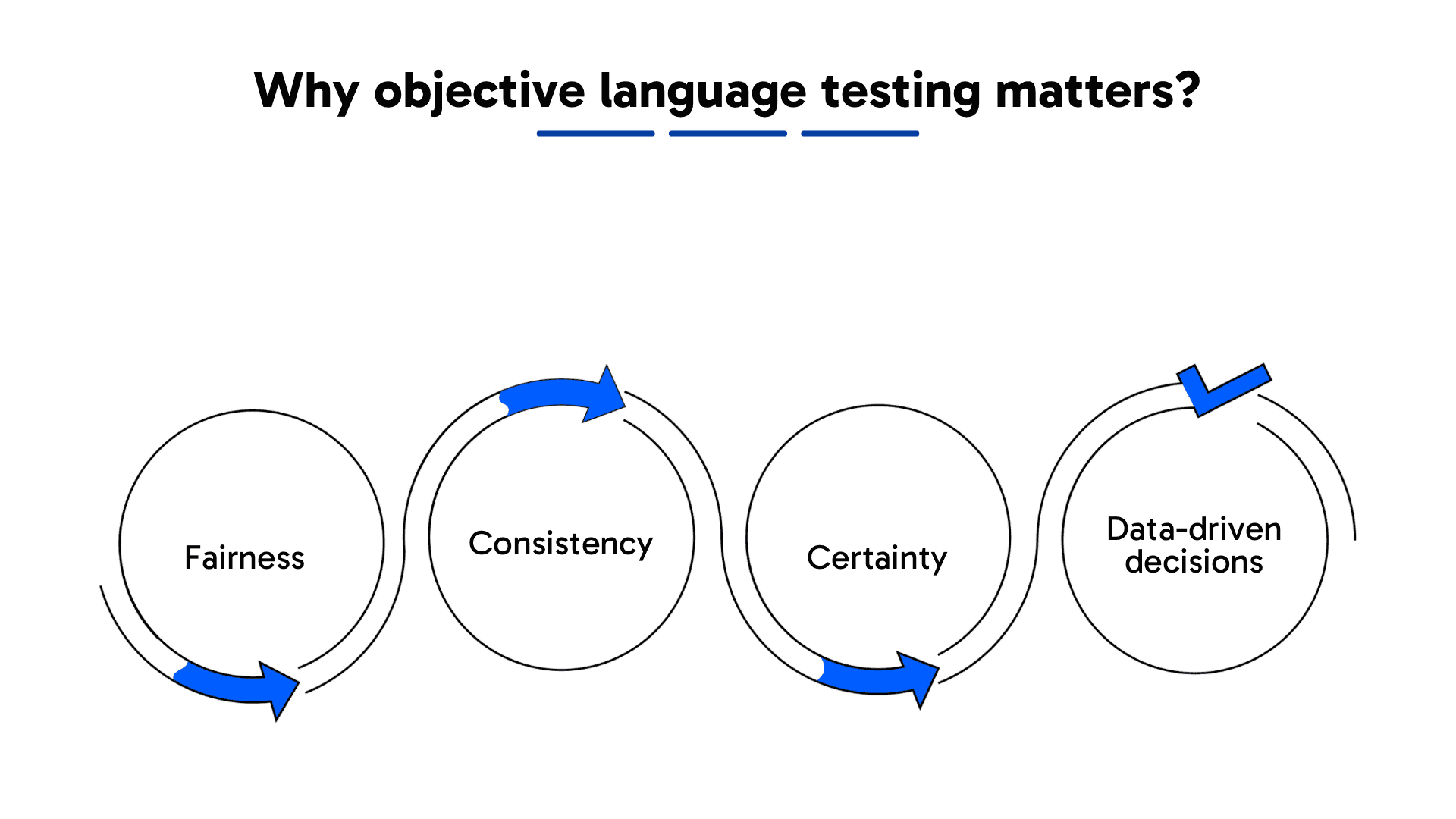
Fairness: Objective tests treat all individuals equally, regardless of their background.
Consistency: Using language proficiency assessment tools ensures results remain uniform across different groups.
Certainty: It allows you to confidently place individuals in the right role or program based on their skills.
Data-driven decisions: Employers and educators can rely on clear, unbiased results to make informed choices.
Objective tests significantly reduce errors in recruitment giving you better hires based on real language skills. Using the right tools ensures a more accurate picture of someone’s ability to communicate, whether in school or the workplace.
Comparison of Tool Features and Capabilities
When choosing the right language proficiency assessment tools, comparing their features and capabilities is essential. Each tool offers different strengths depending on your needs, whether for academic purposes or business language testing. To help you make an informed decision, here’s a comparison of five leading tools based on key features.
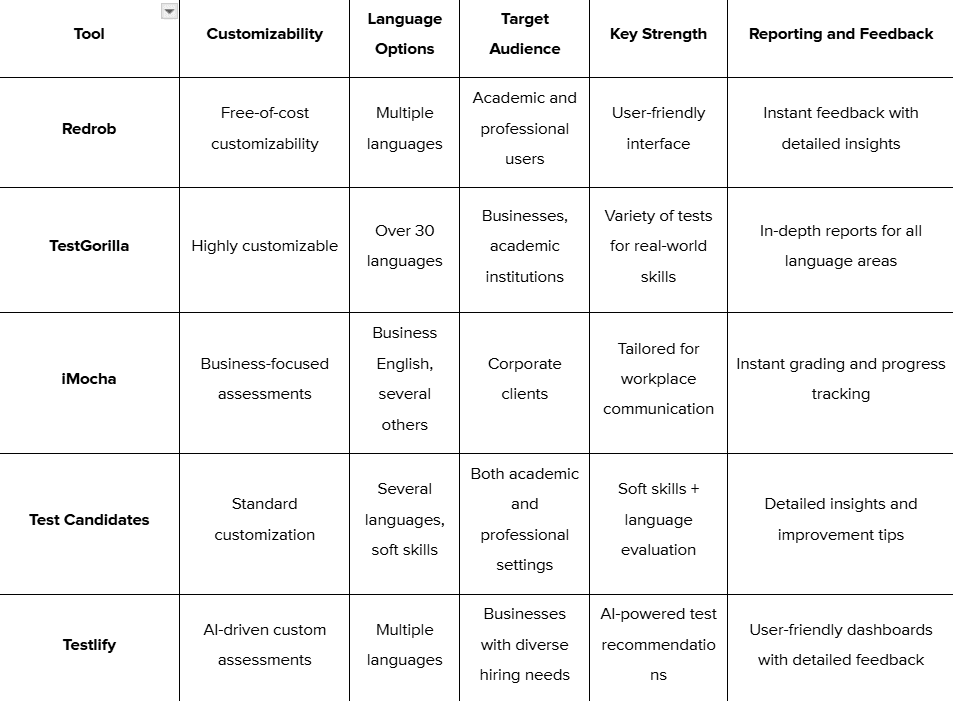
Each of these tools has unique features that cater to different testing requirements. Whether you need customizable tests or real-time reporting, this comparison table helps you find the most suitable tool for your specific needs.
Best Practices for Selecting the Appropriate Tool
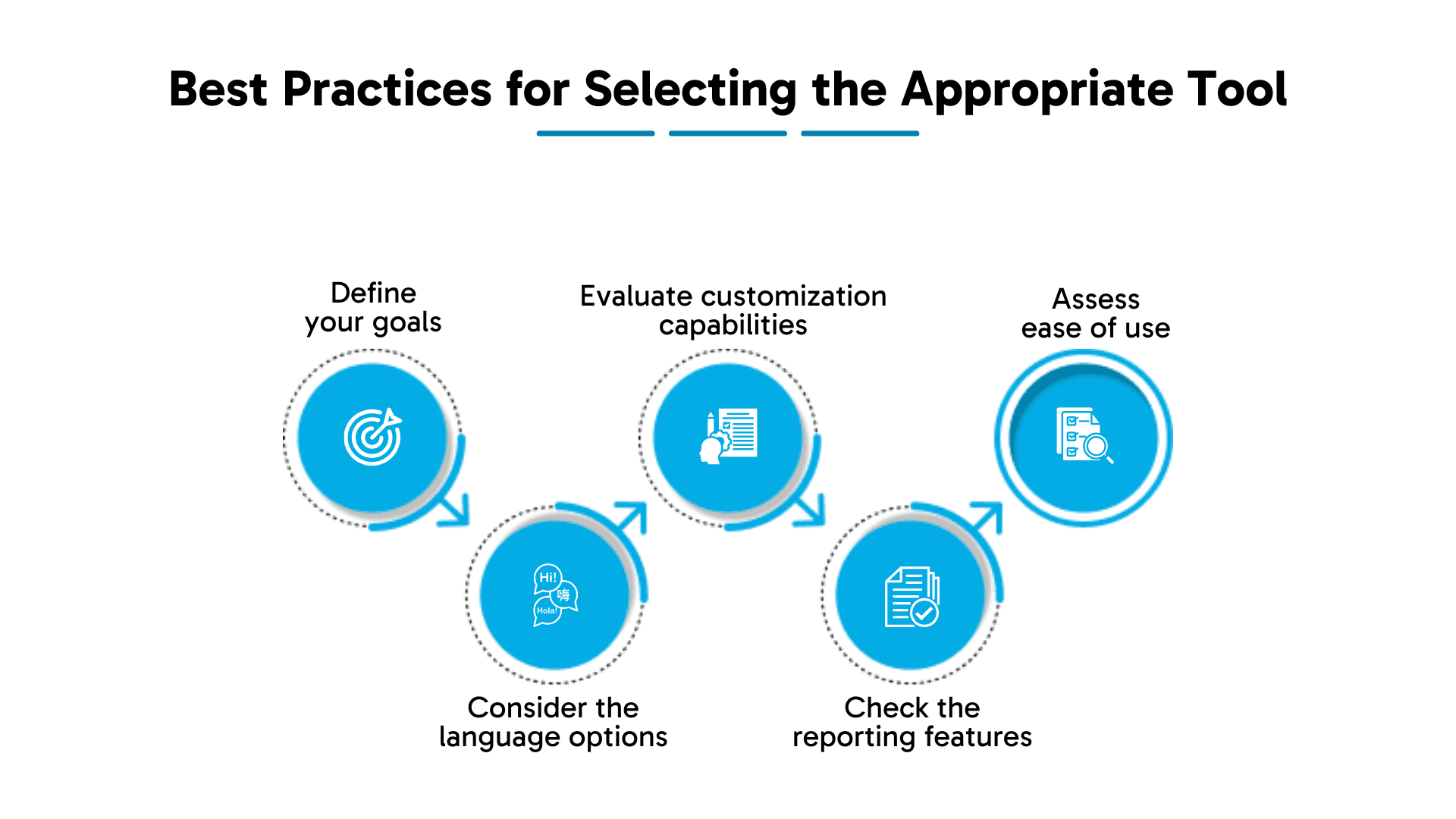
Choosing the right language proficiency assessment tools can significantly impact your testing outcomes. It’s important to consider key factors to ensure the tool meets your needs effectively. Here are some best practices to help guide your decision.
1. Define your goals
Start by identifying what you want to achieve with the assessments. Are you testing for academic placement, job qualifications, or professional communication? This will help you select tools that align with your objectives.
2. Consider the language options
Make sure the tool offers the languages you need to assess. Some tools specialize in specific languages, while others offer a broader range. Choose one that covers the languages your candidates or students need to be tested in.
3. Evaluate customization capabilities
Some language proficiency assessment tools allow you to tailor tests based on your specific needs. If you require unique assessments for different levels or roles, choose a tool that offers customizable options.
4. Check the reporting features
Detailed reporting is crucial for understanding the results. Ensure the tool provides clear feedback and actionable insights. Instant feedback and detailed reports will help you track progress and make informed decisions.
5. Assess ease of use
The tool should be simple for both administrators and test-takers. A user-friendly platform saves time and ensures smooth testing experiences for everyone involved.
By following these practices, you can select the most suitable language proficiency assessment tools that match your needs and objectives.
Evaluating the effectiveness of the tools is essential for accurate assessments. Next, let’s understand the value and impact of language testing in academic and professional contexts.
The Value and Impact of Language Testing
Language testing plays a crucial role in both academic and professional settings. It helps individuals and organizations make informed decisions regarding language abilities. By using reliable language proficiency assessment tools, you can assess current knowledge, set learning goals, and ensure job suitability.
Defines Current Knowledge and Guides Future Learning Goals
Language proficiency assessments help you measure your current skill level. They provide clear benchmarks for reading, writing, speaking, and listening abilities. Once you know where you stand, it’s easier to set future learning goals.
For example, if a candidate scores low in writing but high in speaking, educators can focus on improving writing skills. By using accurate testing, you can create a structured plan for future growth.
Certifies Language Skill Levels for Job Suitability
In the workplace, certified language skills are essential for many roles. Language proficiency assessment tools help employers identify candidates who meet the necessary language requirements for a job. This ensures that employees can communicate effectively, both with customers and within the team.
For instance, an international company may require employees to have a certain level of proficiency in English or another language. These certifications give employers confidence in the candidate’s ability to handle job-related tasks that involve communication.
Empowers Educators and Employers to Assess Proficiency Effectively
For educators and employers, assessing language proficiency is key to making informed decisions. Language proficiency assessment tools offer an efficient and objective way to evaluate skills, saving time while providing reliable results. Educators can place students in the right level, while employers can hire individuals suited for communication-heavy roles.
The ability to objectively assess language skills ensures that no one is placed in a position they can’t handle. This not only improves learning outcomes but also enhances job performance.
Understanding the value of language testing highlights its importance in both education and employment.
Conclusion
Language proficiency assessments are essential for measuring communication skills in both academic and professional settings. They help you understand current language abilities and provide direction for improvement. Choosing the right language proficiency assessment tools is key to ensuring accurate and fair evaluations. By selecting tools that match your needs, you can better assess and develop the language skills of students, employees, or job candidates.
Looking ahead, advancements in technology will continue to impact the future of language assessments. With AI-powered tools and more personalized testing options, evaluating language proficiency will become even more precise and efficient. Staying updated on these innovations ensures you’re using the best methods available.
Language proficiency assessment tools are progressing, making it easier to assess skills in new and improved ways.
While there are various platforms to help you with this, Redrob stands out with all of its assessment features, candidate management, and AI-powered recruiting solutions at affordable prices. Want to hire 92% faster and save 88% of hiring costs? Get to know us better.
